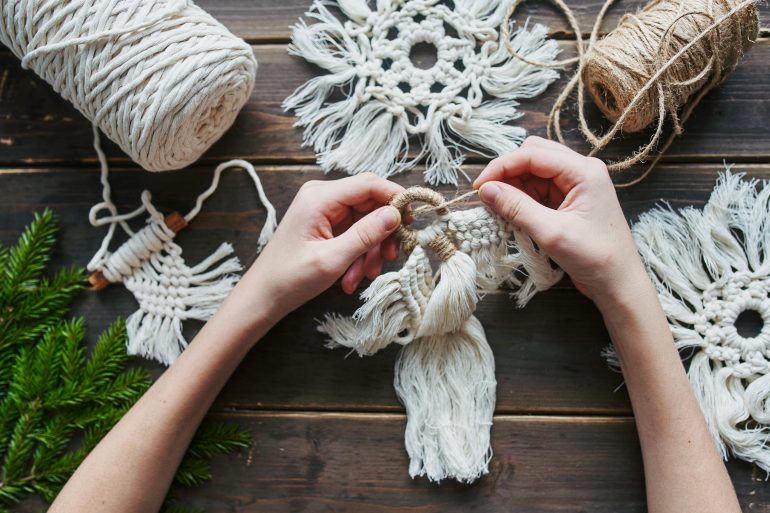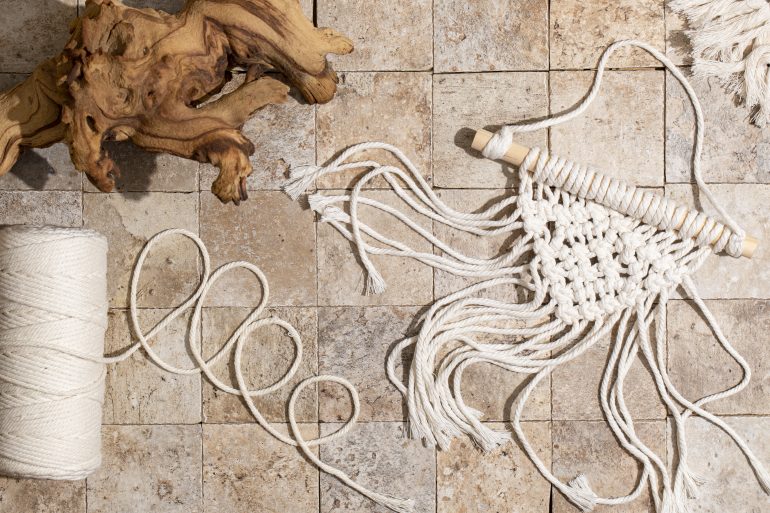Macramé, a form of textile created using knotting techniques, has its roots in the artisan skills of ancient civilisations.
At its core, the answer to the question ‘what is macramé’ is relatively straightforward. It’s a traditional art form that involves creating textiles by knotting cords and strings in intricate patterns rather than weaving or knitting them. This technique is used to create a variety of decorative items such as wall hangings, plant holders, and other items of macramé decor, offering both aesthetic appeal and functionality.
Indeed with just a length of cord and your imagination, anyone can start making magical macramé. So if you’ve ever asked ‘what to use for macramé’ or ‘what is macramé thread’ or if you just want to know how to get started with this most beautiful and delicate of crafts, read on.
The Beauty of Macramé

Weaving macrame home decor from cotton threads with a pattern. (Credit: Alena Shafieva via Getty Images)
Originally used to craft decorative and functional items like shawls, veils, and belts, the art form was a testament to the skill and creativity of ancient artists. Fast forward to the 1970s, the question of what is macramé saw a revival as a popular craft for making wall hangings, plant hangers, and other home décor items, a trend that continues to flourish today.
The modern resurgence in macramé’s popularity underscores its versatility and the appreciation for handcrafted, functional art. It’s a form that transcends its practical origins, transforming simple knots into intricate works of beauty, each piece telling a story of craftsmanship, tradition, and artistic innovation.
What cord for macrame is most popular and what are the most popular knots? Let’s take a deep dive into the wonderful world of macramé.
A Short History of Macramé

Crafts made of white cotton threads in a macrame style. (Credit: Ekaterina Goncharova via Getty Images)
Even though it wasn’t called it at the time, macramé decor – intricate woven knots used as decorative features on clothes – is visible in the carvings of ancient Assyrians and Babylonians, perhaps as early as 2000 BC.
The word itself may be derived from the Arabic word migramah which described this type of knotted decoration on the edges of shawls or veils. It may also come from the Andalusian-Arabic word macramia which may be translated as ‘ornamental fringe‘ or ‘embroidered veil.’ There may also be derivations from the Turkish version of the word, makrama, meaning towel.
As well as for decoration, macramé also had a practical purpose. In North Africa, these types of knotted fringes were useful in keeping flies off horses and camels. It was even said that it was a popular pastime of sailors at sea who would use knots to create and mend their nets. They would also make everyday items such as belts, hammocks and bottle holders from macramé and sell their creations when they came ashore.
The artform spread from the Middle East and North Africa into Europe, probably via the Moors in the eighth or ninth century, but it’s believed macramé didn’t arrive in England until around the late seventeenth century, where it was highly prized by Queen Mary II.
Macramé decor may have had its golden age in the Victorian era when it was considered to be a popular hobby. However, like most trends, its popularity faded. It wasn’t until the 1970s that the counterculture movement began, again asking the question ‘what is macramé? The 1970s answer produced a plethora of macramé products, including vests, belts, wall hangings, doilies, tablecloths and even flip-flops, but the rampant consumerism of the 1980s once again largely put paid to the popularity of macramé.
Today, with Bohemian style experiencing a renaissance and the cottagecore aesthetic becoming increasingly popular, macramé is enjoying a comeback. Thanks also in part to social media, it’s reaching a global audience who are putting their phones down and picking up macramé cord!
Speaking of macramé cord, what cord for macrame should you use?
What to use for Macramé

Hand made natural cotton macrame decoration hanging on white wall. (Credit: Anastasiia Krivenok via Getty Images)
Choosing what cord for macramé projects is essential to ensure the durability, appearance, and manageability of what you’re making. There are five main types of macramé cord to choose from.
Cotton Cord
This is one of the most versatile cords for macramé. It’s soft, easy to work with and comes in a variety of colours and thicknesses. It’s best for macramé decor at home or to be given as gifts including wall hangings and plant hangers.
Hemp Cord
Used for jewellery, keyrings and small projects, hemp cord is strong, eco-friendly and biodegradable.
Jute Cord
Most people use jute cord for outdoor projects like rugs or doormats. It’s natural, sturdy and has a nice rustic appearance.
Polyester Cord
Similar to cotton cord, polyester cord is versatile, durable and lightweight and can be used for a wide range of macramé crafts.
Nylon Cord
Most beaded macramé projects are made from nylon cord because it’s smooth, strong and available in a wide assortment of colours.
When you’re asking ‘what is macramé thread’, consider your project requirements and personal preferences. You might also want to experiment with different types to find what works best for you.
Thickness
Choose the thickness based on your project. Thicker cords are suitable for larger projects like wall hangings and plant hangers, while thinner cords are suitable for jewellery and smaller crafts.
Texture
Soft cords are easier to work with, while rough cords like jute offer a rustic look.
Strength
Ensure the cord is strong enough to hold the weight for projects like plant hangers.
What is Macramé: What Knot to do?

Macrame accessories on beige background. (Credit: Augustas Cetkauskas via Getty Images)
Macramé is all about knots, and there are seven basic knots that are the foundation for most projects.
Lark’s Head Knot
This is often used to start a macramé project. It involves folding a cord in half and looping it onto a rod or another cord.
Square Knot
This is one of the most common macramé knots used to create the body of a project.
Spiral Knot
This knot creates a twisted effect in the design.
Half Knot
This is similar to the square knot but uses fewer crossings.
Double Half Hitch
This knot is used for making diagonal, straight, or curved lines within the project.
Overhand Knot
This basic knot is often used to finish a piece of macramé work.
Slip Knot
This knot is easy to tie and untie, making it useful for making adjustable closures.
There are dozens of other knots used in macramé projects, including the Cow’s Hitch, the Gathering and the Clove Hitch. These additional knots, along with the seven basic knots, extend the potential of macramé, allowing you to explore hundreds or even thousands of designs, patterns, and textures in your creations.
Tying Up The Loose Ends

Making macrame (Credit: Evgeniia Siiankovskaia via Getty Images)
So what is macramé today? In a world increasingly intertwined with the digital, macramé beckons us back to the tactile and the tangible, offering a hands-on retreat into the realm of artistic expression and functional beauty. Its recent resurgence stands as a testament to its enduring appeal. As we knot, loop, and twist, we join a global community of artists, crafters, and enthusiasts, all united by the interwoven beauty of macramé, continuing a tradition that has transcended cultures, centuries, and generations.












